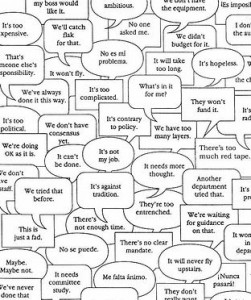 Many people who are passionate about improvement become frustrated when they encounter resistance-to-change.
Many people who are passionate about improvement become frustrated when they encounter resistance-to-change.
It does not matter what sort of improvement is desired – safety, delivery, quality, costs, revenue, productivity or all of them.
The natural and intuitive reaction to meeting resistance is to push harder – and our experience of the physical world has taught us that if we apply enough pressure at the right place then resistance will be overcome and we will move forward.
Unfortunately we sometimes discover that we are pushing against an immovable object and even our maximum effort is futile – so we give up and label it as “impossible”.
Much of Improvement Science appears counter-intuitive at first sight and the challenge of resistance is no different. The counter-intuitive response to feeling resistance is to pull back, and that is exactly what works better. But why does it work better? Isn’t that just giving up and giving in? How can that be better?
To explain the rationale it is necessary to examine the nature of resistance more closely.
Resistance to change is an emotional reaction to an unconsciously perceived threat that is translated into a conscious decision, action and justification: the response. The range of verbal responses is large, as illustrated in the caption, and the range of non-verbal responses is just as large. Attempting to deflect or defuse all of them is impractical, ineffective and leads to a feeling of frustration and futility.
This negative emotional reaction we call resistance is non-specific because that is how our emotions work – and it is triggered as much by the way the change is presented as by what the change is.
Many change “experts” recommend the better method of “driving” change is selling-versus-telling and recommend learning psycho-manipulation techniques to achieve it – close-the-deal sales training for example. Unfortunately this strategy can create a psychological “arms race” which can escalate just as quickly and lead to the same outcome: an emotional battle and psychological casualties. This outcome is often given the generic label of “stress”.
An alternative approach is to regard resistance behaviour as multi-factorial and one model separates the non-specific resistance response into separate categories: Why Do – Don’t Do – Can’t Do – Won’t Do.
The Why Do response is valuable feedback because is says “we do not understand the purpose of the proposed change” and it is not unusual for proposals to be purposeless. This is sometimes called “meddling”. This is fear of the unknown.
The Don’t Do is valuable feedback that is saying “there is a risk with this proposed change – an unintended negative consequence that may be greater than the intended positive outcome“. Often it is very hard to explain this NoNo reaction because it is the output of an unconscious thought process that operates out of awareness. It just doesn’t feel good. And some people are better at spotting the risks – they prefer to wear the Black Hat – they are called skeptics. This is fear of failure.
The Can’t Do is also valuable feedback that is saying “we get the purpose and we can see the problem and the benefit of a change – we just cannot see the path that links the two because it is blocked by something.” This reaction is often triggered by an unconscious recognition that some form of collaborative working will be required but the cultural context is low on respect and trust. It can also just be a manifestation of a knowledge, skill or experience gap – the “I don’t know how to do” gap. Some people habitually adopt the Victim role – most are genuine and do not know how.
The Won’t Do response is also valuable feedback that is saying “we can see the purpose, the problem, the benefit, and the path but we won’t do it because we don’t trust you“. This reaction is common in a low-trust culture where manipulation, bullying and game playing is the observed and expected behaviour. The role being adopted here is the Persecutor role – and the psychological discount is caring for others. Persecutors lack empathy.
The common theme here is that all resistance-to-change responses represent valuable feedback and explains why the better reaction to resistance is to stop talking and start listening because to make progress will require using the feedback to diagnose what components or resistance are present. This is necessary because each category requires a different approach.
For example Why Do requires making the both problem and the purpose explicit; Don’t Do requires exploring the fear and bringing to awareness what is fuelling it; Can’t Do requires searching for the skill gaps and filling them; and Won’t Do requires identifying the trust-eroding beliefs, attitudes and behaviours and making it safe to talk about them.
Resistance-to-change is generalised as a threat when in reality it represents an opportunity to learn and to improve – which is what Improvement Science is all about.
